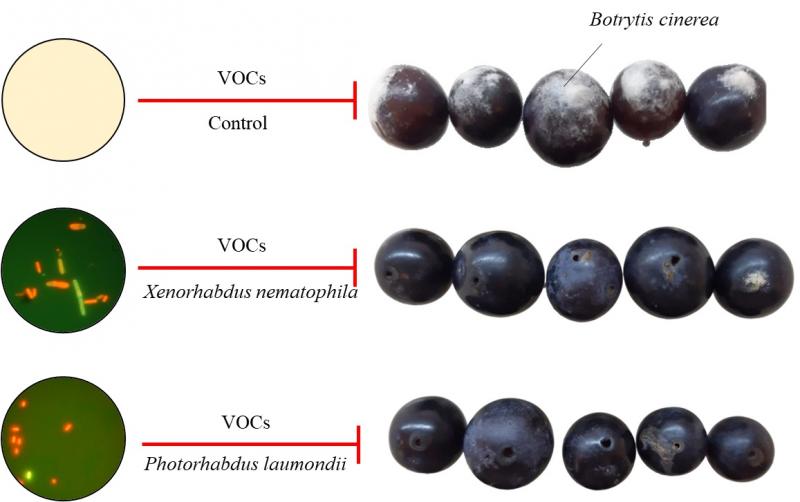The fungus Botrytis cinerea is a significant pathogen that affects a wide variety of crops, as well as a large number of fruits and vegetables after harvest. This fungus causes the well-known gray rot in vineyards and is also responsible for the rot in table grapes and many other vegetables, causing significant economic losses throughout the food supply chain.
New solutions against this pathogen have been studied by the research group IN-vid of the Institute of Grape and Wine Sciences (ICVV), based on the secondary metabolites produced by the symbiotic bacteria of entomopathogenic nematodes, Xenorhabdus spp. and Photorhabdus spp. In a recently published study in the journal BioControl, the effects of Volatile Organic Compounds (VOCs) emitted by the bacteria Xenorhabdus nematophila and Photorhabdus laumondii were analyzed in Tempranillo red grapes and Cherry tomatoes after harvest. The results demonstrated that the VOCs released by these bacteria can significantly reduce the lesions caused by B. cinerea. In grapes and tomatoes, the VOCs produced by X. nematophila and P. laumondii reduced the fungus mycelial growth on the fruit's surface almost completely (over 98% in all cases). Furthermore, it was studied how applying bacterial VOCs on healthy, uninfected grapes can prevent and reduce the future harmful effects of the pathogen. Thus, the prior treatment of un grapes with the VOCs produced by X. nematophila and P. laumondii reduced the subsequent incidence of B. cinerea by 33%, while the control group suffered an incidence of the disease more significantly than 85%.
These findings pave the way for the possible development of tools based on the bacteria Xenorhabdus spp. and Photorhabdus spp. as alternatives for the integrated control of post-harvest diseases in fruits and vegetables. In the coming years, advances in detecting and characterizing bacterial compounds, such as VOCs emitted by certain bacteria, will be crucial in protecting crops and food throughout the supply chain.
For more information:
Vicente Díez, I., Moreira, X., Pastor, V., Vilanova, M., Pou A., & Campos Herrera, R. (2023). Control of post-harvest gray mold (Botrytis cinerea) on grape (Vitis vinifera) and tomato (Solanum lycopersicum) using volatile organic compounds produced by Xenorhabdus nematophila and Photorhabdus laumondii subsp. laumondii. BioControl 183, 10212.
https://doi.org/10.1007/s10526-023-10212-7








